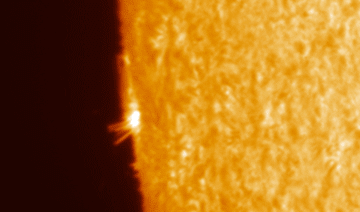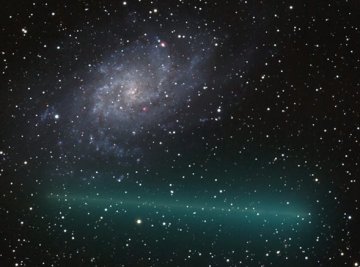 Where's Saturn? Is that a UFO--or the ISS? What's the name of that star? Get the answers from mySKY--a fun new astronomy helper from Meade. Where's Saturn? Is that a UFO--or the ISS? What's the name of that star? Get the answers from mySKY--a fun new astronomy helper from Meade. SOLAR ACTIVITY: On Dec. 31st around 0110 UTC, something exploded just behind the sun's eastern limb. The blast unleashed a C8-class solar flare and hurled a bright CME into space. These events may signal the impending return of large sunspot 978, which has spent the past two weeks transiting the far side of the sun. Almost a full day after the explosion, astrophotographer Gary Palmer of Los Angeles trained his SolarMax90 on the eastern limb of the sun and saw "no more flares, but plenty of undulating plasma." 
The blast site is still seething with activity. But what is it? An old sunspot? An unstable magnetic filament? We should get a better view later today or tomorrow as the sun's rotation brings the tempest over the limb into a direct line of sight from Earth. Stay tuned for updates. more images: from Daisuke Tomiyasu of Higashinada, Kobe, Hyogo, JAPAN; from John Nassr of Baguio, the Philippines; NEW YEARS COMET: Tonight, after sunset, take your binoculars outside and scan the sky right above your head. You may find a little emerald fuzzball--Comet 8P/Tuttle. The comet is making its closest approach to Earth (24 million miles) on Jan. 1st and 2nd. Shining like a ~6th magnitude star, it is barely visible to the unaided eye, but a fine target for binoculars and backyard telescopes: sky map. On Dec. 30th, Tom Victor Kolkin of Notteroy, Norway, caught the comet streaking past spiral galaxy M33: 
"This shows the comet's path for 5 hours and 5 min," says Kolkin who recorded the comet's motion using a 4-inch refracting telescope and a Canon 350D digital camera. On the same night in Payson, Arizona, astrphotographer Chris Schur opened the shutter of his camera for 3 hours and, he says,"what a surprise it was to record a beautifully thin tail streaming from the comet: image." The remarkable green color of the comet recorded so visidly in these snapshots is a sign of cyanogen (CN, a poisonous gas) and diatomic carbon (C2) in the comet's atmosphere. Both substances glow emerald-green when exposed to UV sunlight in the near vacuum of space. Comet 8P/Tuttle Photo Gallery
[World Map of Comet Sightings]
[sky map] [ephemeris] [orbit] [comet binoculars] | 
